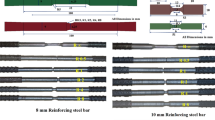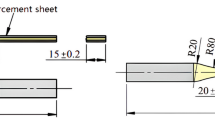Abstract
The present paper deals with an experimental study on the fatigue behavior under bending of plain and steel fiber reinforced concrete (SFRC). Notched beams were tested under three point bending test: both monotonic and fatigue tests on pre-cracked specimens (in which a fracture process zone was present) were performed. In order to quantify the influence of fiber reinforcement on the fatigue performance of SFRC, two volume fractions of fibers (0.5 and 1.0 %) and three fatigue load levels were adopted. Test results are compared in terms of cyclic creep curves and Wöhler diagrams, crack opening rate, toughness and energy dissipation. Experimental results show that the fatigue deformations at failure match the monotonic stress–strain curves with a good agreement. Fibers seem to improve the fatigue life of concrete, whereas their effectiveness tends to decrease under high-cycle fatigue. In both cases, however, the addition of fibers ensures an increase of the energy dissipation at failure.











Similar content being viewed by others
Abbreviations
- CMOD:
-
Crack mouth opening displacement
- CMOD0 :
-
Crack mouth opening displacement of the first cycle
- CMODi :
-
Crack mouth opening displacement of the i-th cycle
- CMODlow :
-
Crack mouth opening displacement at the lower load level applied in the cyclic stage
- CMODu :
-
Crack mouth opening displacement of the last cycle
- CMODupp :
-
Crack mouth opening displacement at the upper load level applied in the cyclic stage
- CTOD:
-
Crack tip opening displacement
- dCMOD/dn:
-
Crack mouth opening rate
- D max :
-
Maximum aggregate diameter
- E c :
-
Concrete elastic modulus
- E cum :
-
Total energy dissipated, cumulative energy
- E diss,i :
-
Energy dissipated at each cycle
- f cm :
-
Mean cylindrical compressive concrete strength
- f cm,cube :
-
Mean cubic compressive concrete strength
- f ctm :
-
Mean cylindrical tensile concrete strength
- f Lk :
-
Characteristic value of limit of proportionality
- f Lm :
-
Mean value of limit of proportionality
- f Rjk :
-
Characteristic flexural tensile strength of fiber reinforced concrete corresponding to CMOD = CMODj
- f Rjm :
-
Mean residual flexural tensile strength of fiber reinforced concrete corresponding to CMOD = CMODj
- h cyl :
-
Height of cylindrical concrete sample
- L f :
-
Fiber length
- L f/ϕ f :
-
Fiber aspect ratio
- LPD:
-
Load point displacement
- N i :
-
Numbers of cycles at CMODi
- N max :
-
Numbers of cycles at failure
- P low :
-
Lower load level applied to the notched beam in the cyclic stage
- P max :
-
Maximum load applied to the notched beam
- P max,Nmax :
-
Maximum applied load when reaching the envelope curve
- P upp :
-
Upper load level applied to the notched beam in the cyclic stage
- R 2 :
-
Coefficient of determination
- S :
-
Ratio between P upp and P max
- V f :
-
Volume fraction of fibers
- ΔCMOD:
-
Crack mouth opening range
- ϕ cyl :
-
Diameter of cylindrical concrete sample
- ϕ f :
-
Fiber diameter
References
Di Prisco M, Felicetti R, Plizzari GA (eds) Fibre-reinforced concrete (FRC). In: Proceedings of the 6th International RILEM Symposium (BEFIB 2004), Varenna, Italy, 20–22 Sept 2004, Bagneux—France: RILEM Publications s.a.r.l., 2004, ISBN 2-912143-51-9, p 1516
Gettu R (ed) Fibre reinforced concrete: design and applications. In: Proceedings of the 7th International RILEM Symposium (BEFIB 2008), Chennai, India, 17–19 Sept 2008, Bagneux—France: RILEM Publications s.a.r.l., 2008, ISBN: 978-2-35158-064-6, p 1153
Barros JAO et al (eds) Fibre reinforced concrete: challenges and opportunities, CD & Proceeding book of abstracts of the 8th RILEM International Symposium (BEFIB 2012), Guimarães, Portugal, 19–21 Sept 2012, Bagneux—France: RILEM Publications s.a.r.l., ISBN: 978-2-35158-132-2; e-ISBN: 978-2-35158-133-9, p 314
Tiberti G, Minelli F, Plizzari G (2015) Cracking behavior in reinforced concrete members with steel fibers: a comprehensive experimental study. Cem Concr Res 68:24–34. doi:10.1016/j.cemconres.2014.10.011
Plizzari GA, Tiberti G. Structural behavior of SFRC tunnel segments. In: Proceedings of the 6th International Conference on Fracture Mechanics of Concrete and Concrete Structures, Catania (Italy) 17–22 June 2007, vol 3, p 1577–1584. ISBN 978-0-415-44066-0
Meda A, Plizzari GA (2004) A new design approach for SFRC slabs on grade based on fracture mechanics. ACI Struct J 101(3):298–303
Belletti B, Cerioni R, Meda A, Plizzari G (2008) Design aspects on steel fiber reinforced concrete pavements. ASCE J Mater Civ Eng 20(9):599–607. doi:10.1061/(ASCE)0899-1561(2008)20:9(599)
Krstulovic-Opara N, Haghayeghi AR, Haidar M, Krauss PD (1995) Use of conventional and high-performance steel-fiber reinforced concrete for bridge deck overlays. ACI Mater J 92(6):669–677
Germano F, Tiberti G, Plizzari G, Colombo A (2015) Experimental behavior of precast HSFRC columns in steel socket foundation under cyclic loads. Eng Struct 102:230–248. doi:10.1016/j.engstruct.2015.07.052
Germano F, Tiberti G, Plizzari G (2016) Experimental behavior of SFRC columns under uniaxial and biaxial cyclic loads. Compos Part B Eng 85:76–92. doi:10.1016/j.compositesb.2015.09.010
Caballero-Morison KE, Bonet JL, Navarro-Gregori J, Martí-Vargas JR (2012) Behaviour of steel fibre—reinforced normal—strength concrete slender columns under cyclic loading. Eng Struct 39:162–175. doi:10.1016/j.engstruct.2012.02.003
Zanotti C (2014) High performance FRC for R/C structure strengthening, Università degli Studi di Brescia—DICATAM Quaderni del Dottorato 3, Rome (Italy), Jan 2014, Aracne Editrice, p 232, ISBN 978-88-548-7008-6
ACI Committee 215 (1992) Consideration for design of concrete structures subjected to fatigue loading. ACI Journal 1992, Proceedings; 71(3): 97–121
RILEM Committee 36-RDL (1984) Long-term random dynamic loading of concrete structures. RILEM Mater Struct 17(97):1–28
Comité Euro-International Du Béton (CEB) (1988) Fatigue of concrete structures—state of the art report. Bullettin d’Information 188:1–75
Holmen JO (1979) Fatigue of concrete by constant and variable amplitude loading. PhD thesis, Division of Concrete Structures, Norwegian Institute of Technology, University of Trondheim, p 218
Hsu TTC (1981) Fatigue of plain concrete. ACI J 78:292–305
Reinhardt HW (1984) Fracture mechanics of elastic softening material like concrete. Heron 29(2):43
Saito M (1987) Characteristics of microcracking in concrete under static and repeated tensile loading. Cem Concr Res 17:211–218
Cornelissen HAW, Reinhardt HW (1984) Uniaxial tensile fatigue failure of concrete under constant-amplitude and programme loading. Mag Concr Res 36(129):216–226. doi:10.1680/macr.1984.36.129.216
Hordijk DA (1991) Local approach to fatigue of concrete, PhD thesis, Delft University of Technology 1991, p 210, ISBN 90-9004519-8
Slowik V, Plizzari GA, Saouma V (1996) Fracture of concrete under variable amplitude fatigue loading. ACI Mater J 93(3):272–283
Hillerborg A, Modeer M, Petersson PE (1976) Analysis of crack formation and crack growth in concrete by means of fracture mechanics and finite elements. Cem Concr Res 6:773–782
Lee MK, Barr BIG (2004) An overview of the fatigue behaviour of plain and fiber reinforced concrete. Cem Concr Compos 26:299–305. doi:10.1016/S0958-9465(02)00139-7
Cachim PB, Figueiras JA, Pereira PAA (2002) Fatigue behavior of fiber-reinforced concrete in compression. Cem Concr Compos 24(2):211–217. doi:10.1016/S0958-9465(01)00019-1
Yin W, Hsu TTC (1995) fatigue behavior of steel fiber reinforced concrete in uniaxial and biaxial compression. ACI Mater J 92(1):71–80
Grzybowski M, Meyer C (1993) Damage accumulation in concrete with and without fiber reinforcement. ACI Mater J 90(6):594–604
Otter DE, Naaman AE (1988) Properties of steel fiber reinforced concrete under cyclic loading. ACI Mater J 85(4):254–261
Zhang J, Stang H (1998) Fatigue performance in flexure of fiber reinforced concrete. ACI Mater J 95(1):58–67
Johnston CD, Zemp RW (1991) Flexural fatigue performance of steel fiber reinforced concrete—influence of fiber content, aspect ratio, and type. ACI Mater J 88(4):374–383
Plizzari GA, Cangiano S, Alleruzzo S (1997) The fatigue behaviour of cracked concrete. Fatigue Fract Eng Mater Struct 20(8):1195–1206
Plizzari GA, Cangiano S, Cere N (2000) Post-peak behavior of fiber-reinforced concrete under cyclic tensile loads. ACI Mater J 97(2):182–192
European Committee for Standardization. Eurocode 2: design of concrete structures—part 1: general rules and rules for buildings (EN 1992-1-1); 2004
EN 197-1:2000/A3:2007. Cement—part 1: composition, specifications and conformity criteria for common cements
Bolomey J (1948) Granulation continue ou discontinue des Bétons. Revue des Matériaux de Constructions & Travaux Publix 48:218–219
ACI Committee 544. Guide for specifying, proportioning, mixing, placing and finishing steel fiber reinforced concrete. ACI Report 544.3R-93, American Concrete Institute 1998, p 10
Kooiman AG (2000) Modelling steel fiber reinforced concrete for structural design, Ph.D-thesis, Department of Structural and Building Engineering, Delft University of Technology, 2000. ISBN 90-73235-60-X
UNI 6556. Testing concrete. Determination of Secant Modulus of Elasticity in compression, 1976, 3 p
EN 12350-2. Testing fresh concrete—part 2: slump-test, 2009
EN 14651. Test method for metallic fibre concrete—measuring the flexural tensile strength (limit of proportionally (LOP), residual). European Committee for Standardization; 2005, p 18
International Federation for Structural Concrete (fib). Model code 2010, Final Complete Draft, fib bulletins 65 and 66, March 2012-ISBN 978-2-88394-105-2 and April 2012-ISBN 978-2-88394-106-9 (2012)
Germano F (2014) Cyclic behavior of steel fiber reinforced concrete: from material to seismic columns, Università degli Studi di Brescia—DICATAM Quaderni del Dottorato 5, Rome (Italy), July 2014, Aracne Editrice, p 364, ISBN 978-88-548-7003-1
Spark PR (1982) The influence of rate of loading and material variability on the fatigue characteristics of concrete. ACI Spec Publ 75:331–342
Acknowledgments
A special acknowledgement goes to Eng. M. Pezzola, Eng. M. Arici, Eng. F. Donarini and Eng. L. Manfrin, in carrying out the experimental tests and data processing. Sincere thanks are extended to the technicians A. Botturi, D. Caravaggi, A. Delbarba of the structural laboratory of the University of Brescia, for their support in the experimental activities. The Authors are also thankful to Bekaert Corp. for providing the fiber reinforcement.
Author information
Authors and Affiliations
Corresponding author
Rights and permissions
About this article
Cite this article
Germano, F., Tiberti, G. & Plizzari, G. Post-peak fatigue performance of steel fiber reinforced concrete under flexure. Mater Struct 49, 4229–4245 (2016). https://doi.org/10.1617/s11527-015-0783-3
Received:
Accepted:
Published:
Issue Date:
DOI: https://doi.org/10.1617/s11527-015-0783-3




